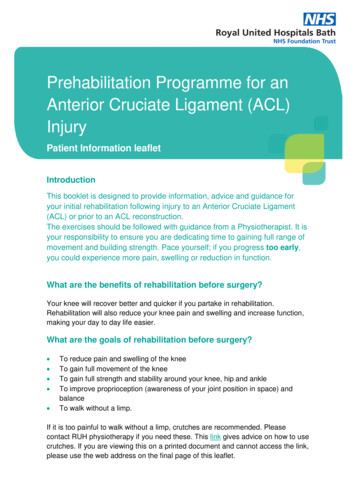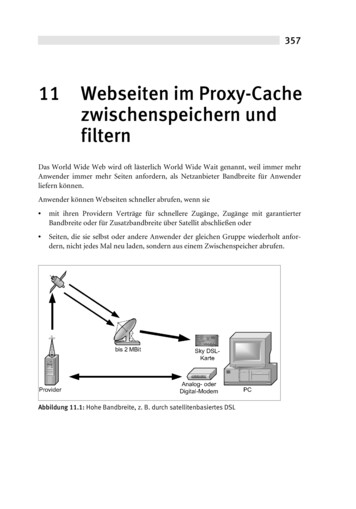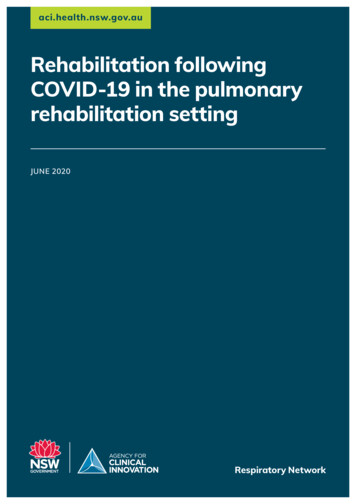
Transcription
Prehabilitation Programme for anAnterior Cruciate Ligament (ACL)InjuryPatient Information leafletIntroductionThis booklet is designed to provide information, advice and guidance foryour initial rehabilitation following injury to an Anterior Cruciate Ligament(ACL) or prior to an ACL reconstruction.The exercises should be followed with guidance from a Physiotherapist. It isyour responsibility to ensure you are dedicating time to gaining full range ofmovement and building strength. Pace yourself; if you progress too early,you could experience more pain, swelling or reduction in function.What are the benefits of rehabilitation before surgery?Your knee will recover better and quicker if you partake in rehabilitation.Rehabilitation will also reduce your knee pain and swelling and increase function,making your day to day life easier.What are the goals of rehabilitation before surgery? To reduce pain and swelling of the kneeTo gain full movement of the kneeTo gain full strength and stability around your knee, hip and ankleTo improve proprioception (awareness of your joint position in space) andbalanceTo walk without a limp.If it is too painful to walk without a limp, crutches are recommended. Pleasecontact RUH physiotherapy if you need these. This link gives advice on how to usecrutches. If you are viewing this on a printed document and cannot access the link,please use the web address on the final page of this leaflet.
PREHABILITATION PROGRAMME FOR AN ANTERIOR CRUCIATE LIGAMENT (ACL) INJURYExercise programmeBefore starting the strengthening exercises, you need to have achieved fullmovement of your knee. If you do not have full movement, you should completerange of movement exercises 4-5 times per day.1) Exercises to regain movementFull knee movement is vital for your recovery. The exercises to increase your kneemovement may cause some discomfort.Repeat 10 times, 2-3 times daily, or as pain allows.Knee Straightening(extension)With your ankle resting on a rolledup towel/ similar, pull your ankletowards you and push your kneesagainst the bed or floor tensingyour thigh muscles. Hold for 5seconds before relaxing.Knee Bend(flexion)Resting on the floor or on a bed,bend the affected leg as far aspossible, holding for 5 secondsand relax. To further increasethe movement, use your hand toassist it back.Use your opposite leg to ensure you are bending bothknees equally.Date of publication August 2020 Royal United Hospitals Bath NHS Foundation TrustRef: RUH PHY/034Page 2 of 10
PREHABILITATION PROGRAMME FOR AN ANTERIOR CRUCIATE LIGAMENT (ACL) INJURY2) Strengthening exercisesIt is important that you strengthen your main muscle groups (quadriceps,hamstrings, gluteals, calves). Ideally, both of your legs should have the samemuscle power.Be aware of pain: soreness during the exercise is quite normal but you should nothave increased pain the next day. If this is the case, reduce the amount ofexercise you do.Aim for 3 sets x 8-12 reps or until the muscle is exercised to light fatigue.Complete 2-3 times weeklyDate of publication August 2020 Royal United Hospitals Bath NHS Foundation TrustRef: RUH PHY/034Page 3 of 10
PREHABILITATION PROGRAMME FOR AN ANTERIOR CRUCIATE LIGAMENT (ACL) INJURYQuadriceps strengthening – Stage 1Inner Range Quads (video link)Lying on your back, place a firm cushion or rolled up towel under your affected leg.Lift the lower part of your leg so that your heel lifts off the bed.Hold for 5 seconds before relaxing. Complete the exercise until the thigh musclelightly fatigues.Straight Leg Raise (video link)Lying on your back, straighten your affected leg and pull yourtoes towards you and lift your leg to about 15cm above thebed, hold for a second then relax. Complete the exercise untilthe thigh muscle fatigues.Quadriceps strengthening – Stage 2Lunge progressing to SplitLunge (Video link)Stand with legs shoulder width apart.Take a large step forward keeping yourtrailing leg straight. Bend forward kneeto 90 degrees, then step back in onemovement to start position.During the exercise keep your knee aligned over your second toe. To progressfrom the same starting position lunge forward and bend both legs to 90 degrees,keeping weight equally distributed. To progress, use hand held weights. During theexercise keep your knee aligned over your second toe.Quadriceps strengthening – Stage 3Single Leg Sit to StandSitting in a tall chair, have your affected leg bent to 90 degrees and yourunaffected leg straight in front of you. Place all your weight through theaffected leg as you do a sit to stand. From standing, slowly loweryourself down into the chair. During the exercise keep your kneealigned over your second toe. To increase the difficulty further use alower chair or hold weights (aim for 20 reps).Date of publication August 2020 Royal United Hospitals Bath NHS Foundation TrustRef: RUH PHY/034Page 4 of 10
PREHABILITATION PROGRAMME FOR AN ANTERIOR CRUCIATE LIGAMENT (ACL) INJURYHamstring strengthening – Stage 1Standing Hamstring Curls (Video link)Stand holding onto a support, keep your knees together.Bend your affected knee towards your buttocks as far as itwill go and hold for 5 seconds. Add in an ankle weight orresistance band to increase the difficulty.Hamstring strengthening – Stage 2Double / Single Leg Bridge (video link)Lying on your back with feet flat on the floor and knees bent. Gently squeeze yourstomach and buttock muscles and push through your heels to lift your bottom offthe floor. Ensure your hips are level and return to starting position. To make thisharder, straighten your affected leg and lift in the air, in line with the other knee,keeping pelvis in line.Hamstring strengthening – Stage 3Single Leg Romanian Deadlifts(Video link)Stand on the affected leg, holding a weight at hip level in both hands. Straightenthe unaffected leg and gently move it behind you until it is in line with your spine,as you bend forwards so the weight is just above the floor. Gently squeeze yourbottom muscles and return to the upright position.Date of publication August 2020 Royal United Hospitals Bath NHS Foundation TrustRef: RUH PHY/034Page 5 of 10
PREHABILITATION PROGRAMME FOR AN ANTERIOR CRUCIATE LIGAMENT (ACL) INJURYGluteal strengthening – Stage 1Side Lie Hip Abductions (video link)Lie on your unaffected side, bend slightly forward at the hips. Roll slightly forward.With your top leg straight, lift and hold leg to level with the hip for 5 secondswithout rotating your pelvis. Slowly lower back down and then repeat.Progression: Add a resistance band between legs/ use ankle weight.Gluteal strengthening –Stage 2Crab Walks (video link)In a mini squat position with feetshoulder width apart, walksideways 5metres whilstmaintaining the mini squat.Maintain the shoulder widthdistance between your feet. Whenyou have done 5metres in onedirection, go in the other direction and repeat to fatigue.Progression: Increase step length, add a resistance band to your ankles, makingsure you keep the resistance on the band as you walk sideways.Gluteal strengthening – Stage 3Forward Step Ups (Video link)Start with the foot of your affected legon a step and step up onto the step byextending the knee and hip. Bring yourunaffected leg up to 90 degrees. Holdfor 5 seconds at the top and then stepback down with your unaffected leg,lowering through your affected knee.During the exercise keep your knee aligned over your second toe.Progression: Increase the height of the step or use hand weights.Date of publication August 2020 Royal United Hospitals Bath NHS Foundation TrustRef: RUH PHY/034Page 6 of 10
PREHABILITATION PROGRAMME FOR AN ANTERIOR CRUCIATE LIGAMENT (ACL) INJURYCalf strengtheningGastrocnemius Calf Raises (video link)Hold on to something for support whilst standing with the balls of your feet on astep and your knees straight. Slowly go up onto your toes and then return to thestart position of heels off the edge. Aim: 20 reps or to fatigue.Progression: Double leg to single leg. Add weight to your back e.g. rucksack ofbooksSoleus Calf Raises (video link)Hold on to something for support whilst standing with the balls of your feet on astep and your knees bent (45 degrees). Slowly go up onto your toes and thenreturn to the start position of heels off the edge.Aim: 20 reps or to fatigueProgression: Double to single leg. Add weight to your back.Date of publication August 2020 Royal United Hospitals Bath NHS Foundation TrustRef: RUH PHY/034Page 7 of 10
PREHABILITATION PROGRAMME FOR AN ANTERIOR CRUCIATE LIGAMENT (ACL) INJURY3) Balance and proprioception exercisesIt is important that we train balance and proprioception (awareness of joint positionin space) after ACL injury to reduce re-injury risk.Balance and proprioception – Stage 1Single Leg Stand (video link)Starting position: Stand on youraffected leg and hold, keepingshoulders and pelvis in line.Aim: 3 x 30-60 secondsProgress: Close your eyes, turn yourhead whilst maintaining standing, standon an unstable surface (e.g. gym mat,wobble board).Balance and proprioception – Stage 2Clock Face Mini Squat(video link)Starting position: Stand on your affected leg with your knee slightly bent as if youare in the middle of a clock. Whilst standing on this leg, extend your unaffected legout in the direction of numbers on a clock (ultimately doing mini single leg squatson your affected leg).Aim: Go around the clock 3 x clockwise and 3 x anti-clockwiseBalance and proprioception – Stage 3Arabesque Clock (video link)Starting position: Stand on one leg with opposite leg extended slightly behind.Straighten the opposite leg behind you so it is in line with your spine. Bendforward on the supporting leg so your body is horizontal. In this position reachas far as you can whilst maintaining balance, using an object to mark thisposition. Repeat whole movement to touch marker. Reach in differentdirections around an imagined floor clock 12, 3, 6 and 9.Aim: 10 reps in each direction.Date of publication August 2020 Royal United Hospitals Bath NHS Foundation TrustRef: RUH PHY/034Page 8 of 10
PREHABILITATION PROGRAMME FOR AN ANTERIOR CRUCIATE LIGAMENT (ACL) INJURY4) Aerobic exerciseIt is important to maintain general cardiovascular fitness levels. Completing lowimpact exercise is safe and can be effective for relieving knee pain.Work at a moderate intensity for up to 30 minutes using a static bike orcross trainer.5) Plyometric (agility) exercises (video link)When the strength and control of you knee is returning, it is important to graduallyincrease the demand on the knee to be able to withstand jumping and reboundingexercises.Two Legged JumpJump up vertically. Landsoftly; keep your knees overyour second toe andpushing your bottom out in toa squat position.Aim: 20 repetitionsSingle Legged HopHop vertically up. Land softly on one leg, keepyour knees over your second toe and pushyour bottom out in to a squat position.Aim: 20 repetitionsDate of publication August 2020 Royal United Hospitals Bath NHS Foundation TrustRef: RUH PHY/034Page 9 of 10
PREHABILITATION PROGRAMME FOR AN ANTERIOR CRUCIATE LIGAMENT (ACL) INJURYThese exercises should be followed with guidance from a Physiotherapist. It isyour responsibility to ensure you are dedicating time to gaining full range ofmovement and building strength. Pace yourself, if you have pain or swelling, makeyour exercises easier. Use these symptoms as signs of needing to reduceintensity by reducing the number of sets/reps of the exercise.If you have any queries, please do not hesitate to call Physiotherapyreception on (01225) 821241. They will be able to direct you to yourPhysiotherapist.Alternatively, you can email ruh-tr.therapiesoutpatientadmin@nhs.netTo access video links and further support, please visit the Physiotherapywebpage: www.ruh.nhs.uk/kneeRoyal United Hospitals Bath NHS Foundation TrustCombe Park, Bath BA1 3NG(01225) 428331 www.ruh.nhs.ukPlease contact the Patient Advice and Liaison Service (PALS) if you require thisleaflet in a different format, or would like to feedback your experience of thehospital. Email ruh-tr.pals@nhs.net or telephone 01225 825656 / 826319Date of publication August 2020 Royal United Hospitals Bath NHS Foundation TrustRef: RUH PHY/034Page 10 of 10
Prehabilitation Programme for an Anterior Cruciate Ligament (ACL) Injury . Patient Information leaflet . Introduction This booklet is designed to provide information, advice and guidance for










